Local police tackle Lismore's big problem of domestic violence
Liina Flynn
02 December 2020, 4:21 AM
 Pictured: The rates of domestic assault in a one year period in the 2480 postcode as seen on the website of the Bureau of Crime Statistics and Research (BOCSAR).
Pictured: The rates of domestic assault in a one year period in the 2480 postcode as seen on the website of the Bureau of Crime Statistics and Research (BOCSAR).When the local head of police says that 30% of police work in the Richmond District Police District is family and domestic violence related, the extent of the problem is clear.
But according to District Commander Superintendent Scott Tanner, the Lismore area is no better or worse than anywhere else in Australia.
“Here we are at 20 year record lows in property crime and theft, but domestic violence is the one we need to deal with – it’s our number one priority,” Supt Tanner said.
Lismore difference
The difference in Lismore, according to Supt Tanner, is how local police deal with domestic violence and react to it.
“Every morning we meet and discuss what happened last night with domestic violence and we follow up,” he said. “We have a whole domestic violence trained team here.”
Reported domestic violence incidents to police range from verbal arguments to assault. Supt Tanner said it comes in various forms, from emotional to physical or financial abuse.
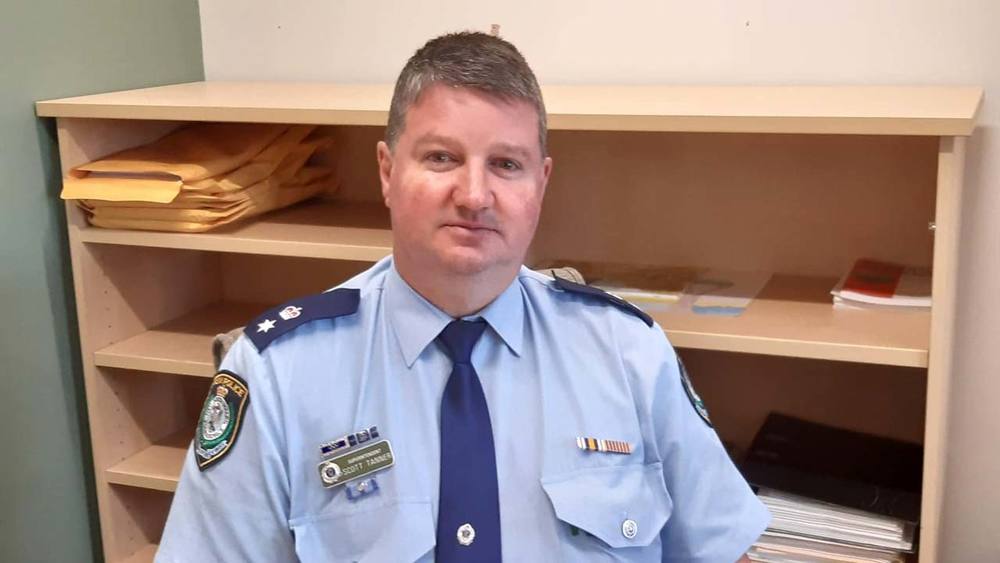
District Commander Superintendent Scott Tanner.
Men or women?
Superintendent Tanner said the vast majority of offenders are men.
“We can’t hide behind that fact - the statistics show the reality,” he said. “Men need to hold other men to account for their behaviour – and our job is to make sure they can’t get away with causing grief to other people.”
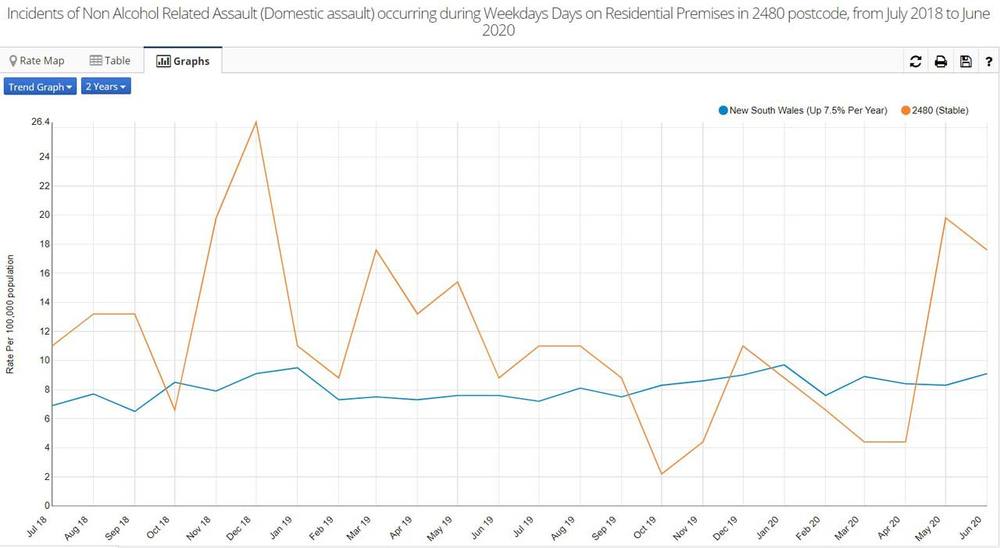
Incidents of domestic assault on residential premises in the day time (above) in the 2480 post code area from July 2019 to June 2020. (Statistics from the Bureau of Crime Statistics and Research).
Note spikes around Christmas time and April to May 2020 when Covid lockdown was happening.
Incidents of domestic assault on residential premises in the night time (below). Note more spikes.
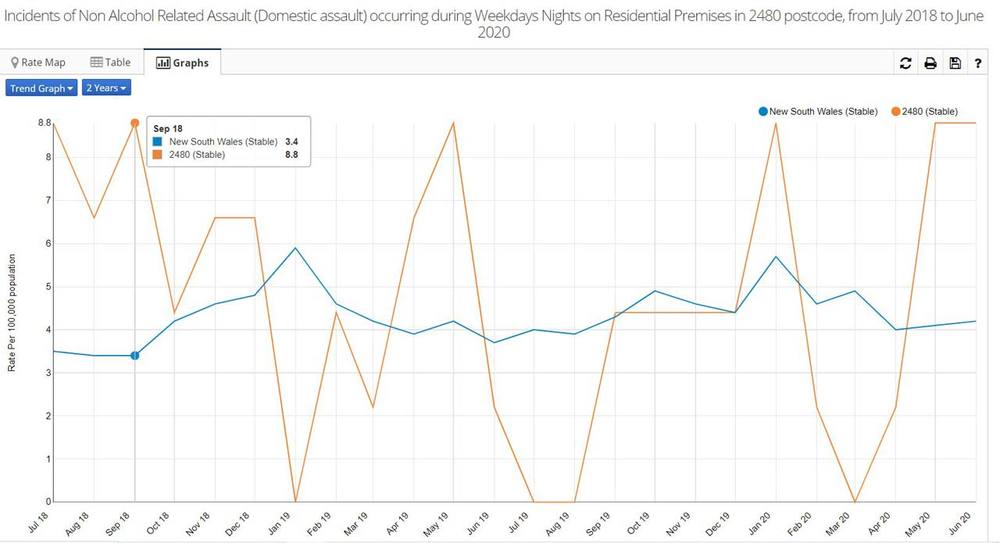
National statistics
According to the Bureau of Statistics (2017), 1 in 3 Australian women have experienced physical and/or sexual violence perpetrated by a man since the age of 15 - and 25% of women and 5% of men have experienced emotional abuse from a current or cohabitating partner.
Local statistics
Every month, local police attend 150 domestic violence matters across the Richmond Police District.
“Out of those, about 30 to 40 are breaches of Apprehended Violence Orders (AVO),” Supt Tanner said.
“We take action on all calls and for the last couple of months, we have had 100% legal action rate – that is –someone has been locked up for every one we’ve been to.”
Legal action
“We also average between 35 to 40 new domestic violence assault reports in the same period - out of those, we have a 90 to 95% legal action rate.
“We have the highest legal action rates in the state and we will continue to push that because we are focussed on the victim and we will do our investigations.”
Supt Tanner said out of the 150 incidents police responded to, there were 70 where no action was taken - because they didn’t reach the “benchmark of criminality”, perhaps where a verbal argument was reported.
Unreported
What about the numbers of incidents that are not reported?
“There’s nothing we can do about them, other than keep on trying to get those people to come forward,” Supt Tanner said.
“That’s where we rely on the community and external agencies – like Family and Community Services (FaCS), health and education to make sure they report what’s happening in the community.
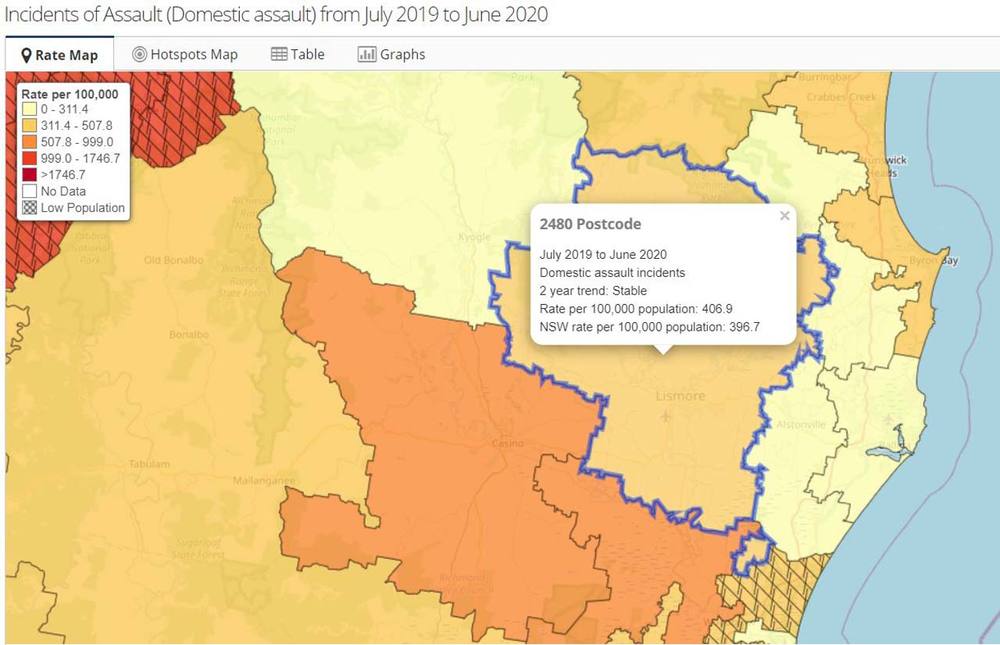
Community responsibility to report
“Sometimes neighbours might hear yelling or shouting, or sometimes friends or neighbours ring and we investigate.
"If people report hearing verbal incidents and we get calls a few times a month, then we will take action. We want people in the community to know they should report and police will take it seriously.
“Police are also a referral point to other services – it’s not all about locking people up – it doesn’t solve the problem we need to make sure we refer the offenders to the appropriate areas.”
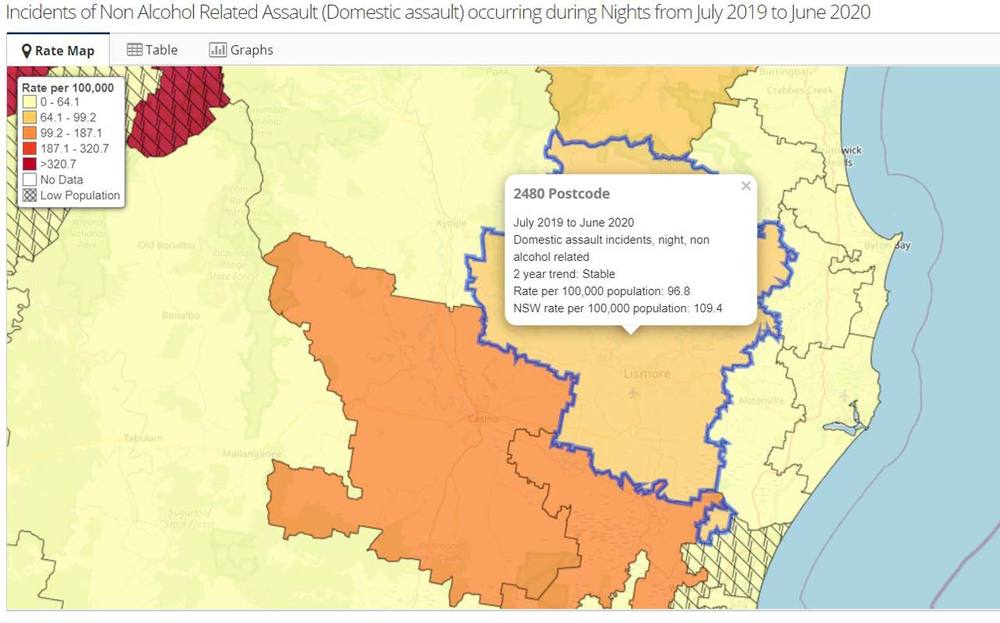
Days were more common than nights for reported incidents of non alcohol related assaults in the 2480 postcode area from July 2019 to June 2020. (Statistics from the Bureau of Crime Statistics and Research)
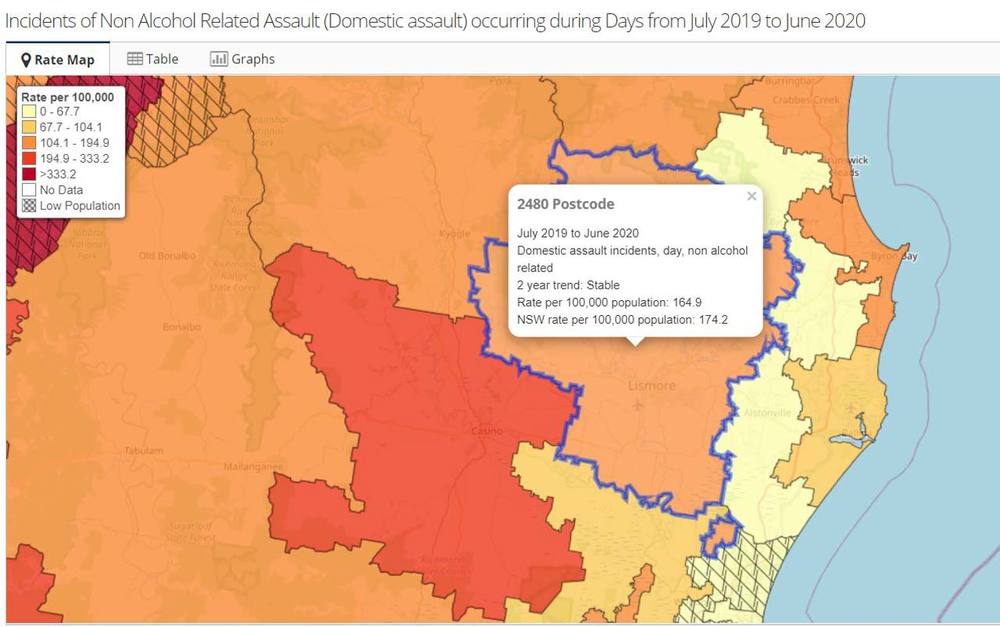
Services available
“Locally we do a lot of work in the victim care space and offender.
“We check in with them and look at the high risk offender group and interact with them every month, making sure they are complying with AVOs orders and complying with bail conditions.
Safety action meeting
“Every two weeks we have a safety action meeting where police, health, community corrections, education and FaCS meet and discuss our high risk victims and make sure they not missing out on any wrap around support services such as counselling.
“Our intensive case management of these victims means our repeat offender rate has dropped dramatically since we brought that meeting in.
“The rate of known offenders repeating domestic violence used to be 30% - now it’s only 12%.”
A repeat offender is one who has three or more reported incidents in six months.
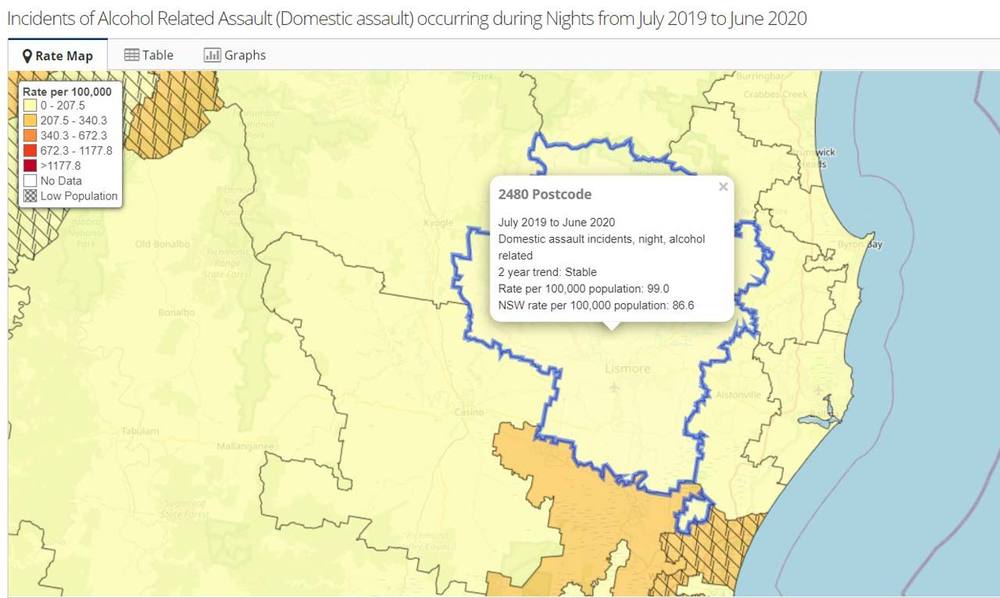
Nights were more common than days for reported incidents of alcohol related assaults in the 2480 postcode area from July 2019 to June 2020. (Statistics from the Bureau of Crime Statistics and Research)
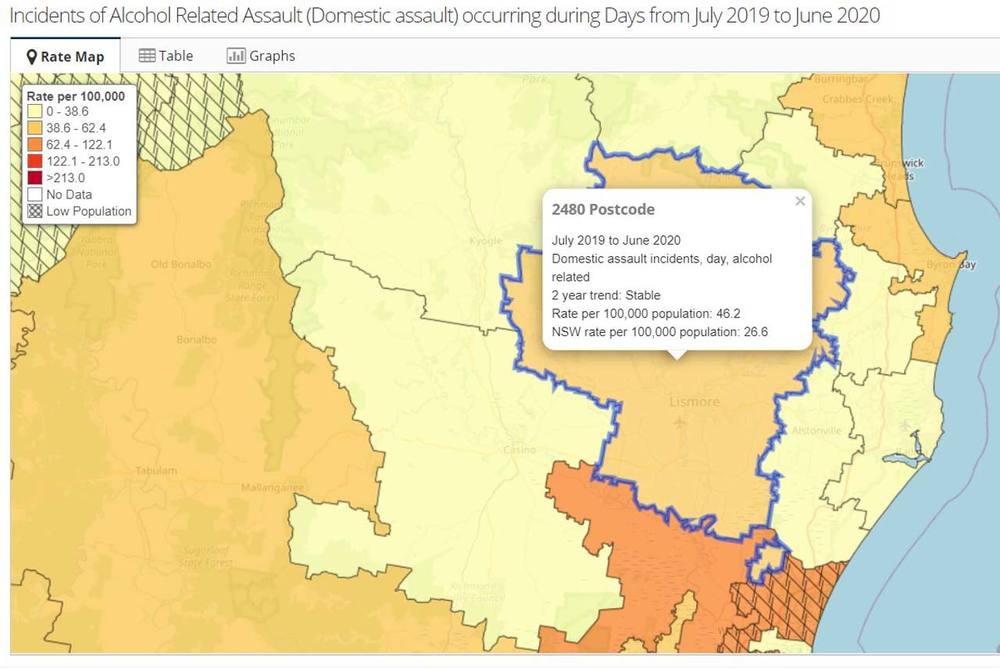
Did Covid affect family and domestic violence rates?
Supt Tanner said in our area, there hasn’t been a real spike in domestic violence incidents since Covid.
“A lot of overseas countries did have a lot of incidents when we all went into lockdown,” he said.
“We anticipated it - because people were at home and there was more chance they would get on each other’s nerves and an incident could happen - but we sent out police to check on people we thought were high risk and held potential offenders to account so they would intimidate their partners.
Court and changes
Supt Tanner said some of the changes in how police respond to domestic violence incidents have lead to less trauma for the victims, as they don’t need to recount what happened over and over.
“These days, when police get called to an incident, we wear our body worn cameras which records our interaction,” he said.
“We record the victim’s statement on that body worn video – and that should be the only time that victim has to relay that story. We play that in court, so the trauma of the victim reliving it has been removed and they do not have to say it again in court and at the station.
Fear and violence
“For someone who has been the victim of family and domestic abuse, violence is often the catalyst for someone to report.
“But when we go into it, they have sometimes had years of emotional and financial intimidatory behaviour before it got to the violent stage.
“In the vast majority of incidents I’ve attended in my 28 years of being in the police force, it’s been the victim who has reported the incident.
“Years ago, the victim never reported domestic violence - it was the hidden thing and police response was poor. But now, we see victims coming forward because we see they will be believed and looked after.
Signs of domestic violence and abuse to look for
“Withdrawing can often be a sign that the person is experiencing intimidation or harassment.
“If it’s your friend you believe suffering is suffering from domestic violence, are you seeing or hearing from them less?
“Do they have no control over their financial security?
“Are their social media accounts suddenly quiet -has their partner taken over their social media accounts?
“Are they wearing excessive makeup or sunglasses?
Trapped
“Victims don’t want to believe it’s happening to them – sometimes when it starts, they think it’s not domestic violence and make excuses for someone else’s behaviour.
“Everyone deserves happiness, so don’t feel like you are trapped - there is so much more in life you can do.
“Your home should be your castle where you feel safest.
Stop the violence
“If you want it to stop, police can make it stop – through restraining orders or legal action or referring offenders to services.
“There are key moments in changing offender behaviour – the time of arrest and when they are sitting in the dock in court thinking about what’s gone wrong. These moments are important for us to refer them to counselling and other services in order to see changes happen.”
Find help
As well as the links to helping services in the Lismore App directory (as listed at the bottom of the story) you can also call the following numbers for assistance:
Men's Referral Service (national referral service)
1300 766 491
Men and Family Centre (Lismore)
(02) 6622 6116
GOV'T SERVICES





